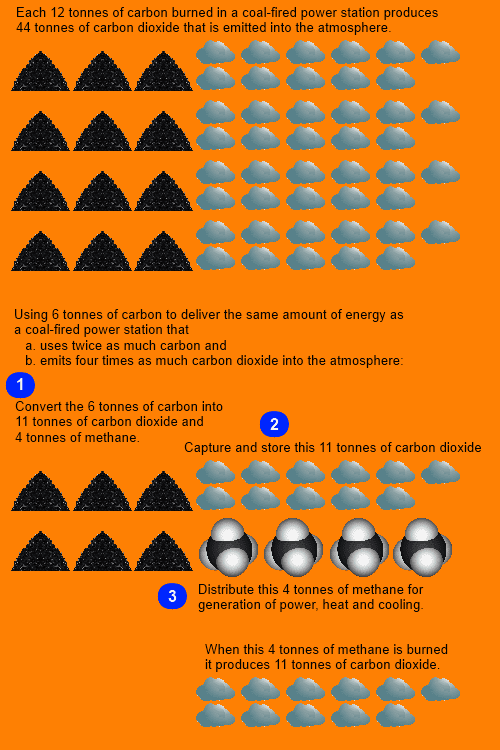Why choose between solar and coal when you can use both?
Global Energy Production will increase dramatically by 2035, regardless of energy-efficiency improvements in developed economies.
1.5 billion people have no access to electricity, and 85% of the population in Africa don't yet have electricity. There is enormous unmet demand for access to electricity and clean energy.
In its annual Human Development Report, the UN Development Progamme (UNDP) said the UN has designated 2012 as the international year of sustainable energy for all. Read more on Health without energy? - Without clean, modern energy people's health can be severely affected
Consider a region perhaps in China or India that has a 600 Megawatt coal-fired power station, and it wants to double this generating capacity.
What do some of the options look like and how do they compare on cost and carbon dioxide emissions?
- One option is to build another 600 Megawatt coal-fired power station.
- Another option is to build a 600 Megawatt concentrated solar thermal power station with sufficient thermal energy storage to allow it to operate reliably overnight and after one or two cloudy days.
- A further option is to replace the existing 600 Megawatt coal-fired power station with a 1200 Megawatt combined-cycle gas turbine (CCGT) power station, and optionally generate the fuel for this power station using the coal supply from the existing 600 Megawatt coal-fired power station with a much smaller concentrated solar thermal (CST) field of heliostats.
For
option 1, the coal supply has to be doubled, and CO2 emissions also double. CO2 emissions intensity is constant at 0.8 tonnes per Megawatt-hour.
For
option 2, a very large and costly
field of heliostats is needed. The thermal energy storage system for reliable operation overnight and after one or two cloudy days is a substantial proportion of the total cost, and even then does not provide reliable operation in periods of extended cloud cover. CO2 emissions remain constant, because the existing coal-fired power station continues operation as before. CO2 emissions intensity of the combined existing and new systems is halved to 0.4 tonnes per Megawatt-hour.
For
option 3, a new combined-cycle gas turbine (CCGT) power station is needed, and the existing coal-fired power station is decommissioned. The coal supply from the decommissioned power station is converted to
Syngas using a much smaller field of heliostats. Some components of the decommissioned coal power station, such as the coal-handling equipment may be re-used. No thermal energy storage system is required: this need is met by storing Syngas for continuous power generation. CO2 emissions remain constant: the new power station is consuming the same quantity of coal as the existing coal power station it replaces. However it produces twice the amount of electrical energy so the CO2 emissions intensity is halved to 0.4 tonnes per Megawatt-hour. Note that the solar thermal gasification of coal in this option provides the same benefit as a Carbon Capture and Storage system that removes 50 percent of the CO2 emissions of a coal-fired power station.
Note:
Option 3 achieves the same outcomes as option 2. That is, total electricity output capacity is doubled to 1200 Megawatts, CO2 emissions do not increase, no additional fossil fuel is needed, and CO2 emissions intensity is halved to 0.4 tonnes per Megawatt-hour.
Essentially these are two technologically different solutions with nearly identical economic and environmental benefits. (Option 3 overcomes criticism that solar energy sources are intermittent and hence unreliable without "backup" fossil fuel power plants.
Option 3 also eliminates toxic mercury and other emissions of the existing coal-fired power station that is retained in Option 2.)
The choice between options 2 and 3 can be based on a comparison of their cost and a consideration of the added benefits of option 3.
Coal-Fired Power Station (Option 1)
Assuming this power station achieves 40% thermal efficiency, with CO2 emissions of 0.8 tonnes per Megawatt-hour:
Input Thermal Energy from Coal: 1500 Megawatts per hour
Output Electrical Energy: 600 Megawatts per hour
CO2 Emissions: 480 tonnes per hour
 |
| Figure 1: Coal-fired Power Station Model |
Concentrated Solar Thermal (CST) Power Station (Option 2)
Assuming this power station achieves 40% thermal efficiency, with zero CO2 emissions per Megawatt-hour:
Input Thermal Energy from Concentrated Solar Thermal (CST): 1500 Megawatts per hour
Output Electrical Energy: 600 Megawatts per hour
CO2 Emissions: 0 tonnes per hour
 |
| Figure 2: Concentrated Solar Thermal (CST) Power Station Model |
Concentrated Solar Thermal (CST) Coal/Biomass Gasification (Option 3 - part 1)
Assuming this power station achieves 40% thermal efficiency, with zero CO2 emissions per Megawatt-hour:
Input Thermal Energy from Coal/Biomass: 1500 Megawatts per hour
Input Thermal Energy from Concentrated Solar Thermal (CST): 500 Megawatts per hour
Output Thermal Energy in Purified Syngas: 2000 Megawatts per hour (This is transferred to the Combined-Cycle Gas Turbine (CCGT) power station below - where it is used the generate electricity)
CO2 Emissions: 0 tonnes per hour
 |
| Figure 3: Concentrated Solar Thermal (CST) Coal/Biomass Gasifier |
Combined-Cycle Gas Turbine (CCGT) Power Station (Option 3 - part 2)
Assuming this power station achieves 60% thermal efficiency, with CO2 emissions of 0.4 tonnes per Megawatt-hour:
Input Thermal Energy from Syngas/Natural Gas: 2000 Megawatts per hour (This is transferred from the Concentrated Solar Thermal (CST) Coal/Biomass Gasification plant above)
Output Electrical Energy: 1200 Megawatts per hour
CO2 Emissions: 480 tonnes per hour
 |
| Figure 4: Combined-Cycle Gas Turbine (CCGT) Power Station Model |
For details of research on solar thermal gasification see this post on
Concentrated Solar Thermal energy Meets Biomass CHP











